Stefanie Jegelka
Department of Electrical Engineering and Computer Science, Massachusetts Institute of Technology, Cambridge, MA, USA
Sequential-Parallel Duality in Prefix Scannable Models
Jun 12, 2025Abstract:Modern neural sequence models are designed to meet the dual mandate of parallelizable training and fast sequential inference. Recent developments have given rise to various models, such as Gated Linear Attention (GLA) and Mamba, that achieve such ``sequential-parallel duality.'' This raises a natural question: can we characterize the full class of neural sequence models that support near-constant-time parallel evaluation and linear-time, constant-space sequential inference? We begin by describing a broad class of such models -- state space models -- as those whose state updates can be computed using the classic parallel prefix scan algorithm with a custom associative aggregation operator. We then define a more general class, Prefix-Scannable Models (PSMs), by relaxing the state aggregation operator to allow arbitrary (potentially non-associative) functions such as softmax attention. This generalization unifies many existing architectures, including element-wise RNNs (e.g., Mamba) and linear transformers (e.g., GLA, Mamba2, mLSTM), while also introducing new models with softmax-like operators that achieve O(1) amortized compute per token and log(N) memory for sequence length N. We empirically evaluate such models on illustrative small-scale language modeling and canonical synthetic tasks, including state tracking and associative recall. Empirically, we find that PSMs retain the expressivity of transformer-based architectures while matching the inference efficiency of state space models -- in some cases exhibiting better length generalization than either.
A projection-based framework for gradient-free and parallel learning
Jun 06, 2025Abstract:We present a feasibility-seeking approach to neural network training. This mathematical optimization framework is distinct from conventional gradient-based loss minimization and uses projection operators and iterative projection algorithms. We reformulate training as a large-scale feasibility problem: finding network parameters and states that satisfy local constraints derived from its elementary operations. Training then involves projecting onto these constraints, a local operation that can be parallelized across the network. We introduce PJAX, a JAX-based software framework that enables this paradigm. PJAX composes projection operators for elementary operations, automatically deriving the solution operators for the feasibility problems (akin to autodiff for derivatives). It inherently supports GPU/TPU acceleration, provides a familiar NumPy-like API, and is extensible. We train diverse architectures (MLPs, CNNs, RNNs) on standard benchmarks using PJAX, demonstrating its functionality and generality. Our results show that this approach is as a compelling alternative to gradient-based training, with clear advantages in parallelism and the ability to handle non-differentiable operations.
Learning equivariant models by discovering symmetries with learnable augmentations
Jun 04, 2025Abstract:Recently, a trend has emerged that favors learning relevant symmetries from data in geometric domains instead of designing constrained architectures. To do so, two popular options are (1) to modify the training protocol, e.g., with a specific loss and data augmentations (soft equivariance), or (2) to ignore equivariance and infer it only implicitly. However, both options have limitations: soft equivariance requires a priori knowledge about relevant symmetries, while inferring symmetries merely via the task and larger data lacks interpretability. To address both limitations, we propose SEMoLA, an end-to-end approach that jointly (1) discovers a priori unknown symmetries in the data via learnable data augmentations, and (2) softly encodes the respective approximate equivariance into an arbitrary unconstrained model. Hence, it does not need prior knowledge about symmetries, it offers interpretability, and it maintains robustness to distribution shifts. Empirically, we demonstrate the ability of SEMoLA to robustly discover relevant symmetries while achieving high prediction accuracy across various datasets, encompassing multiple data modalities and underlying symmetry groups.
G1: Teaching LLMs to Reason on Graphs with Reinforcement Learning
May 24, 2025Abstract:Although Large Language Models (LLMs) have demonstrated remarkable progress, their proficiency in graph-related tasks remains notably limited, hindering the development of truly general-purpose models. Previous attempts, including pretraining graph foundation models or employing supervised fine-tuning, often face challenges such as the scarcity of large-scale, universally represented graph data. We introduce G1, a simple yet effective approach demonstrating that Reinforcement Learning (RL) on synthetic graph-theoretic tasks can significantly scale LLMs' graph reasoning abilities. To enable RL training, we curate Erd\~os, the largest graph reasoning dataset to date comprising 50 diverse graph-theoretic tasks of varying difficulty levels, 100k training data and 5k test data, all drived from real-world graphs. With RL on Erd\~os, G1 obtains substantial improvements in graph reasoning, where our finetuned 3B model even outperforms Qwen2.5-72B-Instruct (24x size). RL-trained models also show strong zero-shot generalization to unseen tasks, domains, and graph encoding schemes, including other graph-theoretic benchmarks as well as real-world node classification and link prediction tasks, without compromising general reasoning abilities. Our findings offer an efficient, scalable path for building strong graph reasoners by finetuning LLMs with RL on graph-theoretic tasks, which combines the strengths of pretrained LLM capabilities with abundant, automatically generated synthetic data, suggesting that LLMs possess graph understanding abilities that RL can elicit successfully.
Survey on Generalization Theory for Graph Neural Networks
Mar 19, 2025Abstract:Message-passing graph neural networks (MPNNs) have emerged as the leading approach for machine learning on graphs, attracting significant attention in recent years. While a large set of works explored the expressivity of MPNNs, i.e., their ability to separate graphs and approximate functions over them, comparatively less attention has been directed toward investigating their generalization abilities, i.e., making meaningful predictions beyond the training data. Here, we systematically review the existing literature on the generalization abilities of MPNNs. We analyze the strengths and limitations of various studies in these domains, providing insights into their methodologies and findings. Furthermore, we identify potential avenues for future research, aiming to deepen our understanding of the generalization abilities of MPNNs.
Higher-Order Graphon Neural Networks: Approximation and Cut Distance
Mar 18, 2025Abstract:Graph limit models, like graphons for limits of dense graphs, have recently been used to study size transferability of graph neural networks (GNNs). While most literature focuses on message passing GNNs (MPNNs), in this work we attend to the more powerful higher-order GNNs. First, we extend the $k$-WL test for graphons (B\"oker, 2023) to the graphon-signal space and introduce signal-weighted homomorphism densities as a key tool. As an exemplary focus, we generalize Invariant Graph Networks (IGNs) to graphons, proposing Invariant Graphon Networks (IWNs) defined via a subset of the IGN basis corresponding to bounded linear operators. Even with this restricted basis, we show that IWNs of order $k$ are at least as powerful as the $k$-WL test, and we establish universal approximation results for graphon-signals in $L^p$ distances. This significantly extends the prior work of Cai & Wang (2022), showing that IWNs--a subset of their IGN-small--retain effectively the same expressivity as the full IGN basis in the limit. In contrast to their approach, our blueprint of IWNs also aligns better with the geometry of graphon space, for example facilitating comparability to MPNNs. We highlight that, while typical higher-order GNNs are discontinuous w.r.t. cut distance--which causes their lack of convergence and is inherently tied to the definition of $k$-WL--their transferability remains comparable to MPNNs.
Beyond Matryoshka: Revisiting Sparse Coding for Adaptive Representation
Mar 05, 2025
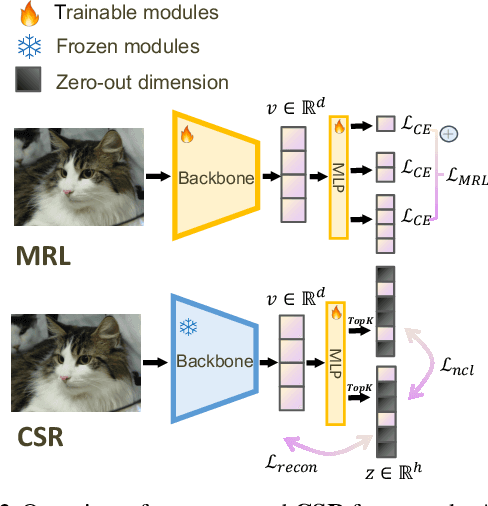
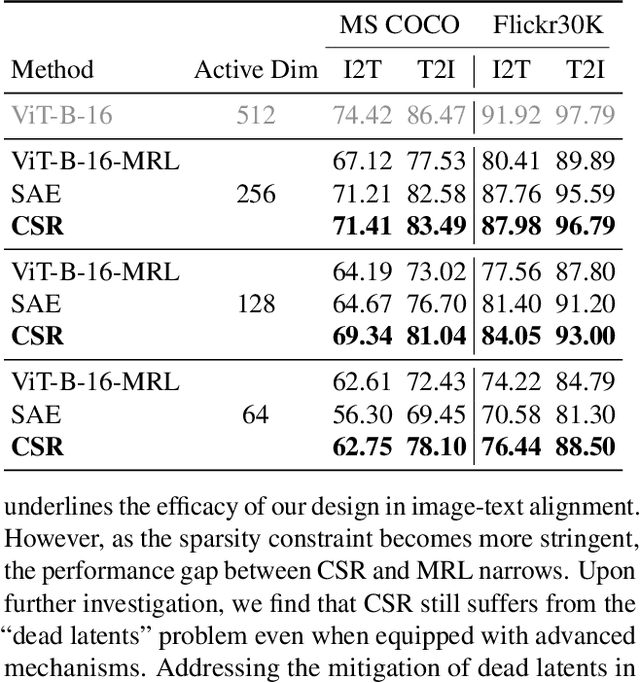
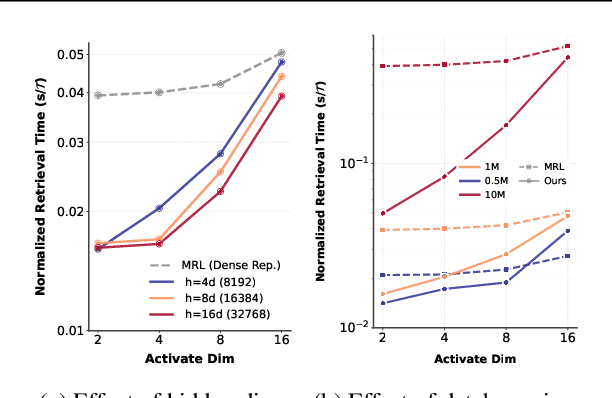
Abstract:Many large-scale systems rely on high-quality deep representations (embeddings) to facilitate tasks like retrieval, search, and generative modeling. Matryoshka Representation Learning (MRL) recently emerged as a solution for adaptive embedding lengths, but it requires full model retraining and suffers from noticeable performance degradations at short lengths. In this paper, we show that sparse coding offers a compelling alternative for achieving adaptive representation with minimal overhead and higher fidelity. We propose Contrastive Sparse Representation (CSR), a method that sparsifies pre-trained embeddings into a high-dimensional but selectively activated feature space. By leveraging lightweight autoencoding and task-aware contrastive objectives, CSR preserves semantic quality while allowing flexible, cost-effective inference at different sparsity levels. Extensive experiments on image, text, and multimodal benchmarks demonstrate that CSR consistently outperforms MRL in terms of both accuracy and retrieval speed-often by large margins-while also cutting training time to a fraction of that required by MRL. Our results establish sparse coding as a powerful paradigm for adaptive representation learning in real-world applications where efficiency and fidelity are both paramount. Code is available at https://github.com/neilwen987/CSR_Adaptive_Rep
Learning with Exact Invariances in Polynomial Time
Feb 27, 2025Abstract:We study the statistical-computational trade-offs for learning with exact invariances (or symmetries) using kernel regression. Traditional methods, such as data augmentation, group averaging, canonicalization, and frame-averaging, either fail to provide a polynomial-time solution or are not applicable in the kernel setting. However, with oracle access to the geometric properties of the input space, we propose a polynomial-time algorithm that learns a classifier with \emph{exact} invariances. Moreover, our approach achieves the same excess population risk (or generalization error) as the original kernel regression problem. To the best of our knowledge, this is the first polynomial-time algorithm to achieve exact (not approximate) invariances in this context. Our proof leverages tools from differential geometry, spectral theory, and optimization. A key result in our development is a new reformulation of the problem of learning under invariances as optimizing an infinite number of linearly constrained convex quadratic programs, which may be of independent interest.
Subsampling Graphs with GNN Performance Guarantees
Feb 23, 2025

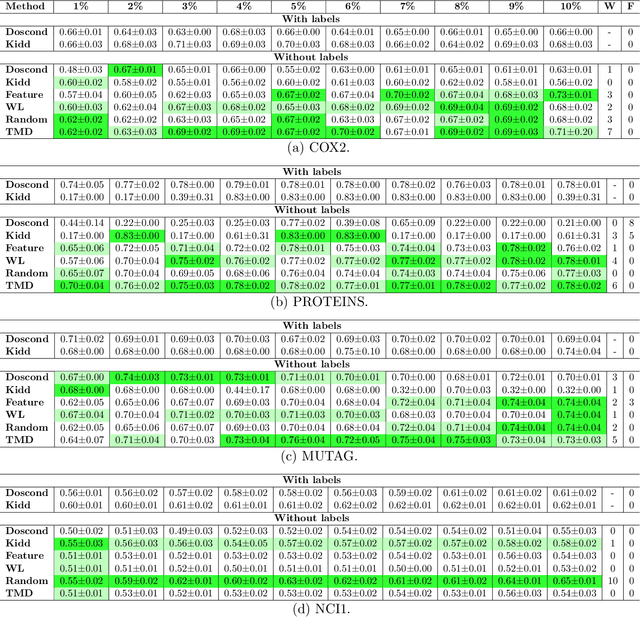
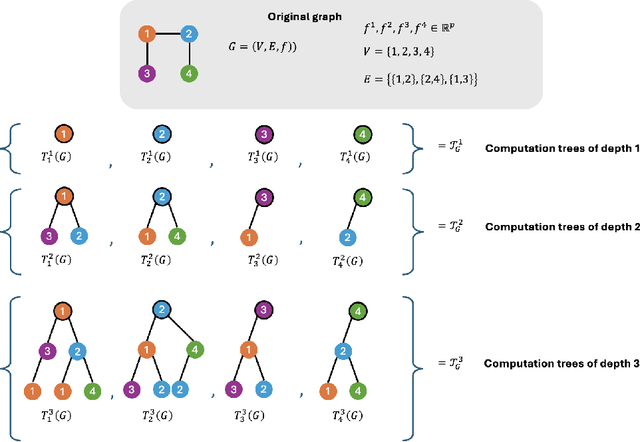
Abstract:How can we subsample graph data so that a graph neural network (GNN) trained on the subsample achieves performance comparable to training on the full dataset? This question is of fundamental interest, as smaller datasets reduce labeling costs, storage requirements, and computational resources needed for training. Selecting an effective subset is challenging: a poorly chosen subsample can severely degrade model performance, and empirically testing multiple subsets for quality obviates the benefits of subsampling. Therefore, it is critical that subsampling comes with guarantees on model performance. In this work, we introduce new subsampling methods for graph datasets that leverage the Tree Mover's Distance to reduce both the number of graphs and the size of individual graphs. To our knowledge, our approach is the first that is supported by rigorous theoretical guarantees: we prove that training a GNN on the subsampled data results in a bounded increase in loss compared to training on the full dataset. Unlike existing methods, our approach is both model-agnostic, requiring minimal assumptions about the GNN architecture, and label-agnostic, eliminating the need to label the full training set. This enables subsampling early in the model development pipeline (before data annotation, model selection, and hyperparameter tuning) reducing costs and resources needed for storage, labeling, and training. We validate our theoretical results with experiments showing that our approach outperforms existing subsampling methods across multiple datasets.
When More is Less: Understanding Chain-of-Thought Length in LLMs
Feb 11, 2025



Abstract:Chain-of-thought (CoT) reasoning enhances the multi-step reasoning capabilities of large language models (LLMs) by breaking complex tasks into smaller, manageable sub-tasks. Researchers have been exploring ways to guide models to generate more complex CoT processes to improve the reasoning ability of LLMs, such as long CoT and the test-time scaling law. However, for most models and tasks, does an increase in CoT length consistently lead to improved reasoning accuracy? In this paper, we observe a nuanced relationship: as the number of reasoning steps increases, performance initially improves but eventually decreases. To understand this phenomenon, we provide a piece of evidence that longer reasoning processes are increasingly susceptible to noise. We theoretically prove the existence of an optimal CoT length and derive a scaling law for this optimal length based on model capability and task difficulty. Inspired by our theory, we conduct experiments on both synthetic and real world datasets and propose Length-filtered Vote to alleviate the effects of excessively long or short CoTs. Our findings highlight the critical need to calibrate CoT length to align with model capabilities and task demands, offering a principled framework for optimizing multi-step reasoning in LLMs.
 Add to Chrome
Add to Chrome Add to Firefox
Add to Firefox Add to Edge
Add to Edge